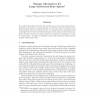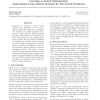217 search results - page 1 / 44 » On the Fine Structure of Large Search Spaces |
ICTAI
1999
IEEE
13 years 9 months ago
1999
IEEE
Recently there has been significant progress in our understanding of the computational nature of combinatorial problems. Randomized search methods, both complete and incomplete, o...
CVPR
2006
IEEE
14 years 6 months ago
2006
IEEE
Coarse-to-fine classification is an efficient way of organizing object recognition in order to accommodate a large number of possible hypotheses and to systematically exploit shar...
CPE
1997
Springer
13 years 9 months ago
1997
Springer
We consider the problem of storing and searching a large state space obtained from a high-level model such as a queueing network or a Petri net. After reviewing the traditional te...
ANNS
2010
12 years 12 months ago
2010
Evolving recurrent neural networks for behavior control of robots equipped with larger sets of sensors and actuators is difficult due to the large search spaces that come with the ...
ICML
2005
IEEE
14 years 5 months ago
2005
IEEE
Mappings to structured output spaces (strings, trees, partitions, etc.) are typically learned using extensions of classification algorithms to simple graphical structures (eg., li...


